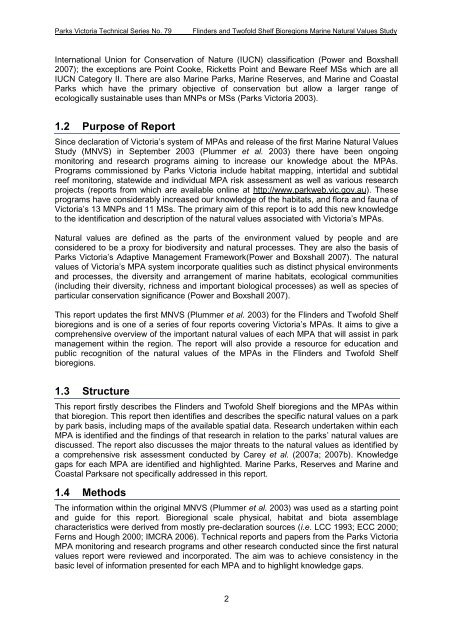parks victoria technical series marine natural values study vol 2 ...
parks victoria technical series marine natural values study vol 2 ...
parks victoria technical series marine natural values study vol 2 ...
You also want an ePaper? Increase the reach of your titles
YUMPU automatically turns print PDFs into web optimized ePapers that Google loves.
Parks Victoria Technical Series No. 79<br />
Flinders and Twofold Shelf Bioregions Marine Natural Values Study<br />
International Union for Conservation of Nature (IUCN) classification (Power and Boxshall<br />
2007); the exceptions are Point Cooke, Ricketts Point and Beware Reef MSs which are all<br />
IUCN Category II. There are also Marine Parks, Marine Reserves, and Marine and Coastal<br />
Parks which have the primary objective of conservation but allow a larger range of<br />
ecologically sustainable uses than MNPs or MSs (Parks Victoria 2003).<br />
1.2 Purpose of Report<br />
Since declaration of Victoria’s system of MPAs and release of the first Marine Natural Values<br />
Study (MNVS) in September 2003 (Plummer et al. 2003) there have been ongoing<br />
monitoring and research programs aiming to increase our knowledge about the MPAs.<br />
Programs commissioned by Parks Victoria include habitat mapping, intertidal and subtidal<br />
reef monitoring, statewide and individual MPA risk assessment as well as various research<br />
projects (reports from which are available online at http://www.parkweb.vic.gov.au). These<br />
programs have considerably increased our knowledge of the habitats, and flora and fauna of<br />
Victoria’s 13 MNPs and 11 MSs. The primary aim of this report is to add this new knowledge<br />
to the identification and description of the <strong>natural</strong> <strong>values</strong> associated with Victoria’s MPAs.<br />
Natural <strong>values</strong> are defined as the parts of the environment valued by people and are<br />
considered to be a proxy for biodiversity and <strong>natural</strong> processes. They are also the basis of<br />
Parks Victoria’s Adaptive Management Framework(Power and Boxshall 2007). The <strong>natural</strong><br />
<strong>values</strong> of Victoria’s MPA system incorporate qualities such as distinct physical environments<br />
and processes, the diversity and arrangement of <strong>marine</strong> habitats, ecological communities<br />
(including their diversity, richness and important biological processes) as well as species of<br />
particular conservation significance (Power and Boxshall 2007).<br />
This report updates the first MNVS (Plummer et al. 2003) for the Flinders and Twofold Shelf<br />
bioregions and is one of a <strong>series</strong> of four reports covering Victoria’s MPAs. It aims to give a<br />
comprehensive overview of the important <strong>natural</strong> <strong>values</strong> of each MPA that will assist in park<br />
management within the region. The report will also provide a resource for education and<br />
public recognition of the <strong>natural</strong> <strong>values</strong> of the MPAs in the Flinders and Twofold Shelf<br />
bioregions.<br />
1.3 Structure<br />
This report firstly describes the Flinders and Twofold Shelf bioregions and the MPAs within<br />
that bioregion. This report then identifies and describes the specific <strong>natural</strong> <strong>values</strong> on a park<br />
by park basis, including maps of the available spatial data. Research undertaken within each<br />
MPA is identified and the findings of that research in relation to the <strong>parks</strong>’ <strong>natural</strong> <strong>values</strong> are<br />
discussed. The report also discusses the major threats to the <strong>natural</strong> <strong>values</strong> as identified by<br />
a comprehensive risk assessment conducted by Carey et al. (2007a; 2007b). Knowledge<br />
gaps for each MPA are identified and highlighted. Marine Parks, Reserves and Marine and<br />
Coastal Parksare not specifically addressed in this report.<br />
1.4 Methods<br />
The information within the original MNVS (Plummer et al. 2003) was used as a starting point<br />
and guide for this report. Bioregional scale physical, habitat and biota assemblage<br />
characteristics were derived from mostly pre-declaration sources (i.e. LCC 1993; ECC 2000;<br />
Ferns and Hough 2000; IMCRA 2006). Technical reports and papers from the Parks Victoria<br />
MPA monitoring and research programs and other research conducted since the first <strong>natural</strong><br />
<strong>values</strong> report were reviewed and incorporated. The aim was to achieve consistency in the<br />
basic level of information presented for each MPA and to highlight knowledge gaps.<br />
2

















